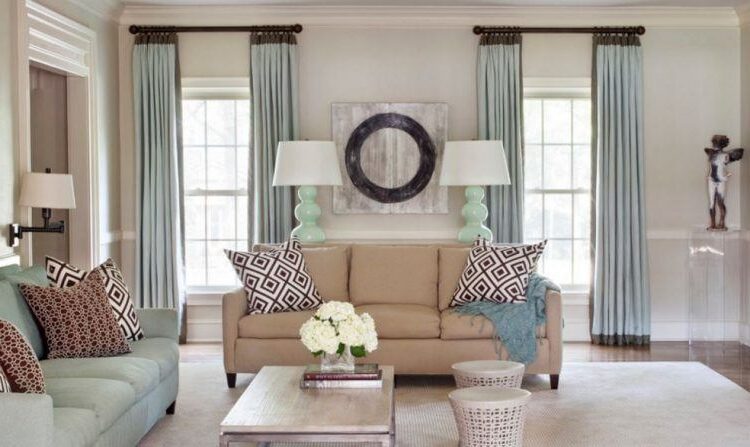Textiles are the soul of interior design. While walls, floors, and furniture create structure, it’s the fabrics—drapes, rugs, throws, pillows, and upholstery—that bring warmth, texture, and personality into a space. Whether you’re aiming for a cozy retreat, a polished hotel-like bedroom, or an eclectic bohemian living room, textiles are the most versatile and affordable way to shape a room’s atmosphere. This article explores how textiles influence design, the types to consider, how to mix patterns and textures, and how to care for them over time.
Why Textiles Matter in Interior Design
- Add softness: Textiles prevent a space from feeling too rigid or sterile.
- Introduce color and pattern: They allow you to bring in visual interest without painting walls.
- Control light and sound: Drapes, rugs, and fabric panels improve acoustics and lighting.
- Convey style: From elegant velvets to rustic linens, each fabric signals a specific design intent.
- Increase comfort: Cushions, throws, and rugs provide tactile comfort and warmth.
Types of Textiles Used in Interior Design
1. Upholstery
Used on sofas, chairs, headboards, and ottomans. Must be durable and comfortable.
2. Drapery and Curtains
Control privacy and light. Can be sheer, blackout, or decorative.
3. Rugs and Carpets
Define zones, absorb sound, and add texture underfoot.
4. Bedding and Throws
Used for layering, warmth, and seasonal updates.
5. Cushions and Pillows
Easily interchangeable and customizable accents.
6. Wall Hangings and Fabric Panels
Serve as art, sound dampeners, or mood setters.
Table: Common Interior Textiles and Their Characteristics
| Textile Type | Best Use Case | Common Fabrics | Care Level | Visual Effect |
|---|---|---|---|---|
| Upholstery | Sofas, chairs | Cotton, linen, velvet | Medium | Defines furniture tone |
| Curtains/Drapes | Windows, room dividers | Linen, silk, polyester | Medium-High | Controls light and softness |
| Rugs/Carpets | Flooring, zoning | Wool, jute, cotton | Medium | Adds depth and comfort |
| Bedding/Throws | Bedrooms, lounges | Flannel, cotton, faux fur | Low | Cozy, layered warmth |
| Cushions/Pillows | Living, bedroom accents | Velvet, cotton, boucle | Low | Color and pattern punches |
| Wall Hangings | Art, sound absorption | Tapestry, wool, felt | Low | Decorative focal point |
Choosing Textiles for Each Room
Living Room
- Use layered textiles—rugs, cushions, and throws.
- Combine upholstery with complementary curtain fabrics.
- Add a bold fabric ottoman for function and visual texture.
Bedroom
- Focus on bedding layers: sheets, quilts, throws, and pillows.
- Use blackout curtains for sleep quality.
- Consider a fabric headboard or bench.
Dining Room
- Use fabric seat cushions or slipcovers.
- Add fabric runners or tablecloths for softness.
- Consider fabric-backed wall panels for acoustic comfort.
Entryway
- Use small rugs for practicality and welcome.
- Add a cushioned bench seat or upholstered stool.
Texture and Layering
Texture creates dimension. Combine smooth and rough, matte and shiny:
- Velvet + linen = luxe and casual
- Leather + wool = strong and soft
- Silk + cotton = refined and grounded
Layering adds interest:
- Layer rugs for depth (e.g., jute base + patterned wool topper)
- Stack pillows with different textures and shapes
- Use varied fabric weights seasonally
Color and Pattern Strategy
- Use textiles to introduce accent colors or balance bold walls.
- Anchor with neutrals, then layer in bolder patterns.
- Stripes and geometrics pair well with florals or solids.
- Use the 60-30-10 color rule (main color – secondary – accent).
Sustainable and Ethical Textiles
More consumers are choosing textiles that are:
- Organic: Grown without pesticides (e.g., organic cotton, hemp)
- Recycled: Fabrics made from repurposed materials
- Fair Trade: Ethically sourced with fair labor practices
- Natural: Wool, silk, bamboo, linen, and jute
Certifications to look for:
- GOTS (Global Organic Textile Standard)
- OEKO-TEX (Free from harmful chemicals)
- Fair Trade Certified
Seasonal Switch-Ups with Textiles
Textiles offer an easy way to refresh your space for the seasons:
- Winter: Wool, faux fur, heavy velvet
- Spring: Linen, light cotton, floral prints
- Summer: Sheers, light throws, jute rugs
- Fall: Earth tones, flannel, knit pillows
Caring for Interior Textiles
- Vacuum rugs regularly to prevent dust buildup
- Wash pillow covers and throws monthly
- Steam curtains to remove wrinkles
- Professional clean upholstery annually
- Store seasonal textiles in fabric bags to avoid moisture
Mixing and Matching Textiles
- Start with one hero fabric—a patterned curtain or pillow
- Add a contrasting solid to ground the pattern
- Include a subtle texture like boucle or embroidery
- Balance warm and cool tones in the same palette
Custom vs Ready-Made Textiles
- Custom: Perfect fit, unique design, but more costly
- Ready-made: Budget-friendly, wide variety, faster delivery
Best of both worlds? Mix—use custom drapes and off-the-shelf pillows.
